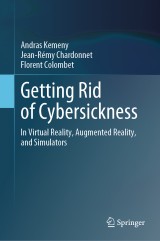Details

Getting Rid of Cybersickness
In Virtual Reality, Augmented Reality, and Simulators|
60,98 € |
|
| Verlag: | Springer |
| Format: | |
| Veröffentl.: | 19.10.2020 |
| ISBN/EAN: | 9783030593421 |
| Sprache: | englisch |
Dieses eBook enthält ein Wasserzeichen.
Beschreibungen
<div>This book provides a concise overview of VR systems and their cybersickness effects, giving a description of possible reasons and existing solutions to reduce or avoid them. Moreover, the book explores the impact that understanding how efficiently our brains are producing a coherent and rich representation of the perceived outside world would have on helping VR technics to be more efficient and friendly to use.</div><div><br></div><div><i>Getting Rid of Cybersickness</i> will help readers to understand the underlying technics and social stakes involved, from engineering design to autonomous vehicle motion sickness to video games, with the hope of providing an insight of VR sickness induced by the emerging immersive technologies. This book will therefore be of interest to academics, researchers and designers within the field of VR, as well as industrial users of VR and driving simulators.</div>
Introduction.- Self-Motion Perception and Cyersickness.- Visualization and Motion Systems.- Reducing Cybersickness.- Applications.- Conclusion.<p></p>
<p>Professor <b>Andras Kemeny</b> is Expert Leader, Immersive Simulation and VR for Renault, Professor at Arts et Métiers Institute of Technology, and Director of LIV, a joint Renault - Arts et Métiers Institute of Technology laboratory. He has worked in several other academic positions, including a position as Associate Research Director at CNRS and College de France and have authored more than 200 scientific papers, books, and industrial patents. His research interests include virtual reality, multimodal perception, autonomous and connected vehicles and driving simulation. He is the inventor of SCANeR, a worldwide leading driving simulation software product. He is President of Driving Simulation Association since 2015, Chairman of the DSC Europe Scientific Committee since 1995, and Guest Editor for several scientific journals.<br></p><p><br></p><p>Associate Professor <b>Jean-Rémy Chardonnet</b> received his Ph.D. degree in robotics from the University of Montpellier II, France, in 2009. He was then with INRIA Grenoble, France, where he developed an awarded hands-on interaction device for virtual reality applications. He is currently Associate Professor at Arts et Métiers Institute of Technology and with LISPEN/Institut Image, Chalon-sur-Saône, France, and leads driving simulation activities at Institut Image. His research interests include virtual reality, multimodal interaction and driving simulation, with a strong focus on cybersickness reduction and personalized interaction. He has published more than 70 papers. He is a member of the DSC Europe VR Scientific Committee and its Organizing Committee.<br></p><br><p></p>
<p>Dr.<b> Florent Colombet</b> graduated in 2006 from Arts et Métiers, Institute of Technology and got his PhD, under the supervision of Pr. Kemeny in 2010 for his work on speed perception in driving simulation. Since then, he has been working at Renault Technocenter in the Driving Simulation & Virtual Reality department and became referent in AD/ADAS driving simulation in 2016. His main topics of interest are motion cueing, motion perception and cybersickness. Dr Colombet is a member of the DSC Europe VR Scientific Committee and its Organizing Committee.</p>
<p>Dr.<b> Florent Colombet</b> graduated in 2006 from Arts et Métiers, Institute of Technology and got his PhD, under the supervision of Pr. Kemeny in 2010 for his work on speed perception in driving simulation. Since then, he has been working at Renault Technocenter in the Driving Simulation & Virtual Reality department and became referent in AD/ADAS driving simulation in 2016. His main topics of interest are motion cueing, motion perception and cybersickness. Dr Colombet is a member of the DSC Europe VR Scientific Committee and its Organizing Committee.</p>
<div>This book provides a concise overview of VR systems and their cybersickness effects, giving a description of possible reasons and existing solutions to reduce or avoid them. Moreover, the book explores the impact that understanding how efficiently our brains are producing a coherent and rich representation of the perceived outside world would have on helping VR technics to be more efficient and friendly to use.</div><div><br></div><div><i>Getting Rid of Cybersickness</i> will help readers to understand the underlying technics and social stakes involved, from engineering design to autonomous vehicle motion sickness to video games, with the hope of providing an insight of VR sickness induced by the emerging immersive technologies. This book will therefore be of interest to academics, researchers and designers within the field of VR, as well as industrial users of VR and driving simulators.</div>
Explores the underlying causes of cybersickness, based the latest scientific literature Provides software and hardware solutions to remove or reduce cybersickness Offers practical recommendations for the use of VR helmets to avoid or reduce cybersickness effects
Diese Produkte könnten Sie auch interessieren:

Mixed-Signal Layout Generation Concepts

von: Chieh Lin, Arthur H.M. van Roermund, Domine Leenaerts

96,29 €

System-Level Design Techniques for Energy-Efficient Embedded Systems

von: Marcus T. Schmitz, Bashir M. Al-Hashimi, Petru Eles

96,29 €














